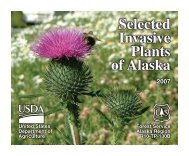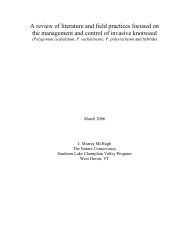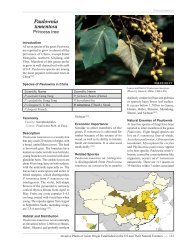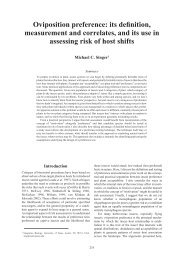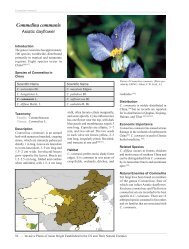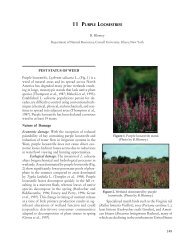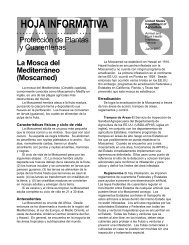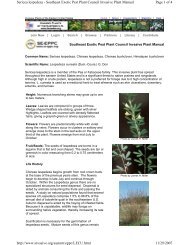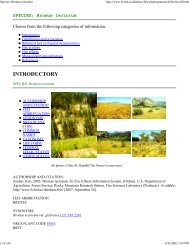Steps for the dissection of male Spodoptera moths and notes on ...
Steps for the dissection of male Spodoptera moths and notes on ...
Steps for the dissection of male Spodoptera moths and notes on ...
Create successful ePaper yourself
Turn your PDF publications into a flip-book with our unique Google optimized e-Paper software.
Julieta Brambila<br />
USDA-APHIS-PPQ<br />
December 2009<br />
<str<strong>on</strong>g>Steps</str<strong>on</strong>g> <str<strong>on</strong>g>for</str<strong>on</strong>g> <str<strong>on</strong>g>the</str<strong>on</strong>g> <str<strong>on</strong>g>dissecti<strong>on</strong></str<strong>on</strong>g> <str<strong>on</strong>g>of</str<strong>on</strong>g> <str<strong>on</strong>g>male</str<strong>on</strong>g> <str<strong>on</strong>g>Spodoptera</str<strong>on</strong>g> <str<strong>on</strong>g>moths</str<strong>on</strong>g> (Lepidoptera:<br />
Noctuidae) <str<strong>on</strong>g>and</str<strong>on</strong>g> <str<strong>on</strong>g>notes</str<strong>on</strong>g> <strong>on</strong> distinguishing S. litura <str<strong>on</strong>g>and</str<strong>on</strong>g> S. littoralis<br />
from native <str<strong>on</strong>g>Spodoptera</str<strong>on</strong>g> species<br />
Introducti<strong>on</strong><br />
The purpose <str<strong>on</strong>g>of</str<strong>on</strong>g> this h<str<strong>on</strong>g>and</str<strong>on</strong>g>out is to guide you in <str<strong>on</strong>g>the</str<strong>on</strong>g> <str<strong>on</strong>g>dissecti<strong>on</strong></str<strong>on</strong>g>, screening, <str<strong>on</strong>g>and</str<strong>on</strong>g><br />
identificati<strong>on</strong> <str<strong>on</strong>g>of</str<strong>on</strong>g> <str<strong>on</strong>g>moths</str<strong>on</strong>g> collected in <str<strong>on</strong>g>Spodoptera</str<strong>on</strong>g> surveys. These instructi<strong>on</strong>s will<br />
help you distinguish <str<strong>on</strong>g>Spodoptera</str<strong>on</strong>g> litura <str<strong>on</strong>g>and</str<strong>on</strong>g> littoralis, <str<strong>on</strong>g>the</str<strong>on</strong>g> targets <str<strong>on</strong>g>of</str<strong>on</strong>g> our surveys,<br />
from various native species, some <str<strong>on</strong>g>of</str<strong>on</strong>g> which are str<strong>on</strong>gly attracted to <str<strong>on</strong>g>the</str<strong>on</strong>g> lures.<br />
Part 1 introduces some genitalic terminology.<br />
Part 2 describes <str<strong>on</strong>g>and</str<strong>on</strong>g> illustrates how to obtain <str<strong>on</strong>g>the</str<strong>on</strong>g> genitalia from specimens<br />
prepared with potassium hydroxide.<br />
Part 3 examines genitalic characters <str<strong>on</strong>g>of</str<strong>on</strong>g> <str<strong>on</strong>g>the</str<strong>on</strong>g> target species.<br />
Part 4 illustrates <str<strong>on</strong>g>the</str<strong>on</strong>g> genitalia <str<strong>on</strong>g>of</str<strong>on</strong>g> native species.<br />
1
Part 1: Genitalic terminology<br />
valve<br />
ampulla<br />
uncus<br />
cucullus<br />
coremata<br />
<str<strong>on</strong>g>Spodoptera</str<strong>on</strong>g> dolichos<br />
aedeagus<br />
<str<strong>on</strong>g>Spodoptera</str<strong>on</strong>g> dolichos<br />
juxta<br />
costal process<br />
clavus<br />
basal sclerite<br />
Right valve<br />
<str<strong>on</strong>g>Spodoptera</str<strong>on</strong>g> pulchella<br />
vesica<br />
Aedeagus<br />
2
Part 2: How to obtain genitalia from processed specimens<br />
1. Place abdomens in dish. Place <strong>on</strong>e abdomen at a time into a glass (or<br />
plastic) dish with alcohol <str<strong>on</strong>g>for</str<strong>on</strong>g> microscope examinati<strong>on</strong>. In time, you can<br />
place 10 or more specimens in <strong>on</strong>e dish, occasi<strong>on</strong>ally replacing <str<strong>on</strong>g>the</str<strong>on</strong>g> alcohol<br />
when it becomes cloudy with scales.<br />
2. Obtaining <str<strong>on</strong>g>the</str<strong>on</strong>g> genitalia. Hold <str<strong>on</strong>g>the</str<strong>on</strong>g> abdomen at <str<strong>on</strong>g>the</str<strong>on</strong>g> base with straight <str<strong>on</strong>g>for</str<strong>on</strong>g>ceps<br />
<str<strong>on</strong>g>and</str<strong>on</strong>g> press it gently with <str<strong>on</strong>g>the</str<strong>on</strong>g> round end <str<strong>on</strong>g>of</str<strong>on</strong>g> curved-tipped <str<strong>on</strong>g>for</str<strong>on</strong>g>ceps from base to<br />
apex to extrude <str<strong>on</strong>g>the</str<strong>on</strong>g> entire genitalia, being very careful not to damage <str<strong>on</strong>g>the</str<strong>on</strong>g><br />
aedeagus by pressing too hard. A small hair brush can be used instead <str<strong>on</strong>g>of</str<strong>on</strong>g><br />
<str<strong>on</strong>g>for</str<strong>on</strong>g>ceps. If <str<strong>on</strong>g>the</str<strong>on</strong>g> genitalia do not exit though <str<strong>on</strong>g>the</str<strong>on</strong>g> apex, gently grab both valves<br />
<str<strong>on</strong>g>and</str<strong>on</strong>g> pull slowly. If <str<strong>on</strong>g>the</str<strong>on</strong>g> abdomen is inflexible, return it to KOH <str<strong>on</strong>g>for</str<strong>on</strong>g> fur<str<strong>on</strong>g>the</str<strong>on</strong>g>r<br />
clearing. If <str<strong>on</strong>g>the</str<strong>on</strong>g> genitalia are obtained, but are not flexible, place <str<strong>on</strong>g>the</str<strong>on</strong>g> genitalia<br />
in <str<strong>on</strong>g>the</str<strong>on</strong>g> warm KOH soluti<strong>on</strong> <str<strong>on</strong>g>for</str<strong>on</strong>g> 5 or 10 more minutes.<br />
Use round <str<strong>on</strong>g>for</str<strong>on</strong>g>ceps to<br />
press <strong>on</strong> <str<strong>on</strong>g>the</str<strong>on</strong>g> abdomen<br />
<str<strong>on</strong>g>Spodoptera</str<strong>on</strong>g> litura<br />
Genitalia extracted from <str<strong>on</strong>g>the</str<strong>on</strong>g> abdomen<br />
3
3. Examining <str<strong>on</strong>g>the</str<strong>on</strong>g> coremata (an external structure), opti<strong>on</strong>al. With <str<strong>on</strong>g>the</str<strong>on</strong>g> left<br />
straight <str<strong>on</strong>g>for</str<strong>on</strong>g>ceps hold <str<strong>on</strong>g>the</str<strong>on</strong>g> genitalia, <str<strong>on</strong>g>and</str<strong>on</strong>g> with <str<strong>on</strong>g>the</str<strong>on</strong>g> back <str<strong>on</strong>g>of</str<strong>on</strong>g> curved-tipped <str<strong>on</strong>g>for</str<strong>on</strong>g>ceps<br />
or using a brush remove some <str<strong>on</strong>g>of</str<strong>on</strong>g> <str<strong>on</strong>g>the</str<strong>on</strong>g> hairs <strong>on</strong> <str<strong>on</strong>g>the</str<strong>on</strong>g> outside <str<strong>on</strong>g>of</str<strong>on</strong>g> <str<strong>on</strong>g>the</str<strong>on</strong>g> valve to<br />
examine <str<strong>on</strong>g>the</str<strong>on</strong>g> coremata (=membranous lobes). Pull gently <strong>on</strong> <str<strong>on</strong>g>the</str<strong>on</strong>g> bottom <str<strong>on</strong>g>and</str<strong>on</strong>g><br />
<str<strong>on</strong>g>the</str<strong>on</strong>g>n <strong>on</strong> <str<strong>on</strong>g>the</str<strong>on</strong>g> top <str<strong>on</strong>g>of</str<strong>on</strong>g> <str<strong>on</strong>g>the</str<strong>on</strong>g> coremata to see if it has <strong>on</strong>e or two lobes. If it <strong>on</strong>ly<br />
has <strong>on</strong>e lobe, <str<strong>on</strong>g>the</str<strong>on</strong>g> specimen is nei<str<strong>on</strong>g>the</str<strong>on</strong>g>r S. litura nor S. littoralis. You may skip<br />
this step, but it is useful during screening.<br />
Coremata with<br />
two lobes<br />
<str<strong>on</strong>g>Spodoptera</str<strong>on</strong>g> litura<br />
4. Opening <str<strong>on</strong>g>the</str<strong>on</strong>g> valves. Grasp each valve <strong>on</strong> its side with <str<strong>on</strong>g>for</str<strong>on</strong>g>ceps <str<strong>on</strong>g>and</str<strong>on</strong>g> gently<br />
open <str<strong>on</strong>g>the</str<strong>on</strong>g>m, tugging a little so that <str<strong>on</strong>g>the</str<strong>on</strong>g>y stay open. It may be helpful to<br />
remove entirely <strong>on</strong>e valve so that it lies <strong>on</strong> its back without having to hold<br />
<str<strong>on</strong>g>the</str<strong>on</strong>g> o<str<strong>on</strong>g>the</str<strong>on</strong>g>r valve open.<br />
<str<strong>on</strong>g>Spodoptera</str<strong>on</strong>g> dolichos<br />
4
5. Examining inner genitalic structures. Several structures need to be<br />
examined to screen <str<strong>on</strong>g>the</str<strong>on</strong>g> target species or to identify which <str<strong>on</strong>g>Spodoptera</str<strong>on</strong>g> species<br />
is at h<str<strong>on</strong>g>and</str<strong>on</strong>g>. They need to be examined from different angles. Refer to <str<strong>on</strong>g>the</str<strong>on</strong>g><br />
terminology at <str<strong>on</strong>g>the</str<strong>on</strong>g> beginning <str<strong>on</strong>g>of</str<strong>on</strong>g> this secti<strong>on</strong>.<br />
<str<strong>on</strong>g>Spodoptera</str<strong>on</strong>g> dolichos<br />
Right valve removed<br />
5
Part 3: Genitalic characters <str<strong>on</strong>g>of</str<strong>on</strong>g> <str<strong>on</strong>g>the</str<strong>on</strong>g> target species<br />
<str<strong>on</strong>g>Spodoptera</str<strong>on</strong>g> litura<br />
<str<strong>on</strong>g>Spodoptera</str<strong>on</strong>g> litura can be identified by <str<strong>on</strong>g>the</str<strong>on</strong>g> shape <str<strong>on</strong>g>of</str<strong>on</strong>g> <str<strong>on</strong>g>the</str<strong>on</strong>g> structures <strong>on</strong> <str<strong>on</strong>g>the</str<strong>on</strong>g> inner surface<br />
<str<strong>on</strong>g>of</str<strong>on</strong>g> <str<strong>on</strong>g>the</str<strong>on</strong>g> valve. The most important character to notice is a set <str<strong>on</strong>g>of</str<strong>on</strong>g> two “windows”<br />
separated by a right angle.<br />
1. Two “windows”, <strong>on</strong>e triangular (1a) <str<strong>on</strong>g>and</str<strong>on</strong>g> <strong>on</strong>e rectangular (1b).<br />
2. Right angle in <str<strong>on</strong>g>the</str<strong>on</strong>g> center <str<strong>on</strong>g>of</str<strong>on</strong>g> <str<strong>on</strong>g>the</str<strong>on</strong>g> valve.<br />
3. Clavus small.<br />
4. Costal process small, el<strong>on</strong>gate, narrow, <str<strong>on</strong>g>and</str<strong>on</strong>g> curved.<br />
5. Ampulla slightly curved.<br />
6. Cucullus truncate (nearly square-edged).<br />
7. Juxta triangular with a narrow base <str<strong>on</strong>g>and</str<strong>on</strong>g> a pointed process.<br />
8. Coremata with two lobes.<br />
<str<strong>on</strong>g>Spodoptera</str<strong>on</strong>g> litura<br />
1a<br />
2<br />
1b<br />
6<br />
ampulla slightly curved (5)<br />
1
Clavus (3) Juxta (7)<br />
Aedeagus<br />
Costal process (4)<br />
Coremata with two<br />
lobes (8)<br />
From a permanent mount.<br />
Modified from M. Pogue (2002).<br />
2
<str<strong>on</strong>g>Spodoptera</str<strong>on</strong>g> littoralis<br />
<str<strong>on</strong>g>Spodoptera</str<strong>on</strong>g> littoralis can be distinguished from native species by a combinati<strong>on</strong> <str<strong>on</strong>g>of</str<strong>on</strong>g><br />
valve characters. It can easily be separated from S. litura by <str<strong>on</strong>g>the</str<strong>on</strong>g> absence <str<strong>on</strong>g>of</str<strong>on</strong>g> <str<strong>on</strong>g>the</str<strong>on</strong>g> two<br />
“windows” in <str<strong>on</strong>g>the</str<strong>on</strong>g> inner surface <str<strong>on</strong>g>of</str<strong>on</strong>g> <str<strong>on</strong>g>the</str<strong>on</strong>g> valves.<br />
1. Large opening at <str<strong>on</strong>g>the</str<strong>on</strong>g> base <str<strong>on</strong>g>of</str<strong>on</strong>g> valve (similar to S. frugiperda).<br />
2. Clavus in <str<strong>on</strong>g>the</str<strong>on</strong>g> shape <str<strong>on</strong>g>of</str<strong>on</strong>g> small bump.<br />
3. Costal process small, el<strong>on</strong>gate, narrow, <str<strong>on</strong>g>and</str<strong>on</strong>g> curved.<br />
4. Ampulla el<strong>on</strong>gate <str<strong>on</strong>g>and</str<strong>on</strong>g> curved.<br />
5. Cucullus truncate (nearly square-edged).<br />
6. Juxta quadrate (=squarish) with two ventrolateral projecti<strong>on</strong>s. This is <str<strong>on</strong>g>the</str<strong>on</strong>g> most<br />
important character, but is difficult to see if it is folded or torn.<br />
7. Coremata with two lobes.<br />
<str<strong>on</strong>g>Spodoptera</str<strong>on</strong>g> littoralis<br />
1<br />
4<br />
5<br />
Clavus (2)<br />
Costal process (3)<br />
3
Ventrolateral<br />
projecti<strong>on</strong><br />
Juxta (6)<br />
Aedeagus<br />
4
Part 4: Genitalic characters <str<strong>on</strong>g>of</str<strong>on</strong>g> native species<br />
<str<strong>on</strong>g>Spodoptera</str<strong>on</strong>g> dolichos<br />
The <str<strong>on</strong>g>male</str<strong>on</strong>g> genitalia <str<strong>on</strong>g>of</str<strong>on</strong>g> <str<strong>on</strong>g>Spodoptera</str<strong>on</strong>g> dolichos are most easily distinguished by <str<strong>on</strong>g>the</str<strong>on</strong>g> shape<br />
<str<strong>on</strong>g>of</str<strong>on</strong>g> <str<strong>on</strong>g>the</str<strong>on</strong>g> clavus, which is similar to a bent thumb, <str<strong>on</strong>g>and</str<strong>on</strong>g> <str<strong>on</strong>g>the</str<strong>on</strong>g> shape <str<strong>on</strong>g>of</str<strong>on</strong>g> <str<strong>on</strong>g>the</str<strong>on</strong>g> basal sclerite.<br />
1. Clavus shaped as a thumb.<br />
2. Costal process small, el<strong>on</strong>gate, narrow, <str<strong>on</strong>g>and</str<strong>on</strong>g> bent.<br />
3. Ampulla el<strong>on</strong>gate <str<strong>on</strong>g>and</str<strong>on</strong>g> curved.<br />
4. Basal sclerite angular.<br />
5. Juxta broad, base c<strong>on</strong>cave.<br />
6. Coremata with two lobes.<br />
<str<strong>on</strong>g>Spodoptera</str<strong>on</strong>g> dolichos<br />
Coremata with two<br />
lobes (6)<br />
Clavus (1)<br />
1<br />
Costal process (2)
Juxta (5)<br />
4<br />
Aedeagus<br />
Ampulla (3)<br />
2
<str<strong>on</strong>g>Spodoptera</str<strong>on</strong>g> ornithogalli<br />
The genitalia <str<strong>on</strong>g>of</str<strong>on</strong>g> <str<strong>on</strong>g>Spodoptera</str<strong>on</strong>g> ornithogalli are most easily distinguished by <str<strong>on</strong>g>the</str<strong>on</strong>g> shape <str<strong>on</strong>g>of</str<strong>on</strong>g><br />
<str<strong>on</strong>g>the</str<strong>on</strong>g> clavus, which resembles a hairy toe. It is nearly identical to <str<strong>on</strong>g>the</str<strong>on</strong>g> genitalia <str<strong>on</strong>g>of</str<strong>on</strong>g> S.<br />
pulchella; notice that <str<strong>on</strong>g>the</str<strong>on</strong>g> coremata are <str<strong>on</strong>g>of</str<strong>on</strong>g> unequal size.<br />
1. Clavus shaped as a hairy toe.<br />
2. Costal process small, el<strong>on</strong>gate, narrow, <str<strong>on</strong>g>and</str<strong>on</strong>g> slightly curved.<br />
3. Ampulla el<strong>on</strong>gate <str<strong>on</strong>g>and</str<strong>on</strong>g> curved.<br />
4. Basal sclerite rounded.<br />
5. Juxta triangular, with l<strong>on</strong>g dorsal process.<br />
6. Coremata with two lobes.<br />
<str<strong>on</strong>g>Spodoptera</str<strong>on</strong>g> ornithogalli<br />
4<br />
Clavus (1) <str<strong>on</strong>g>and</str<strong>on</strong>g><br />
costal process (2)<br />
Ampulla (3) Juxta (5)<br />
1
Coremata with two<br />
lobes (6)<br />
Aedeagus<br />
2
<str<strong>on</strong>g>Spodoptera</str<strong>on</strong>g> pulchella<br />
The genitalia <str<strong>on</strong>g>of</str<strong>on</strong>g> <str<strong>on</strong>g>Spodoptera</str<strong>on</strong>g> pulchella are nearly identical to <str<strong>on</strong>g>the</str<strong>on</strong>g> genitalia <str<strong>on</strong>g>of</str<strong>on</strong>g> S.<br />
ornithogalli. A small spine in <str<strong>on</strong>g>the</str<strong>on</strong>g> vesica <str<strong>on</strong>g>of</str<strong>on</strong>g> <str<strong>on</strong>g>the</str<strong>on</strong>g> aedeagus is <str<strong>on</strong>g>the</str<strong>on</strong>g> distinguishing<br />
characteristic, but is difficult to find. Also, <str<strong>on</strong>g>the</str<strong>on</strong>g> coremata lobes are <str<strong>on</strong>g>of</str<strong>on</strong>g> nearly equal size.<br />
Fortunately, <str<strong>on</strong>g>the</str<strong>on</strong>g> wings are distinctive, plus, apparently, this species is found <strong>on</strong>ly in<br />
sou<str<strong>on</strong>g>the</str<strong>on</strong>g>rn Florida (<str<strong>on</strong>g>and</str<strong>on</strong>g> <str<strong>on</strong>g>the</str<strong>on</strong>g> West Indies).<br />
1. Clavus shaped as a hairy toe.<br />
2. Costal process small, el<strong>on</strong>gate, narrow, <str<strong>on</strong>g>and</str<strong>on</strong>g> ei<str<strong>on</strong>g>the</str<strong>on</strong>g>r straight or slightly curved.<br />
3. Ampulla el<strong>on</strong>gate <str<strong>on</strong>g>and</str<strong>on</strong>g> curved.<br />
4. Basal sclerite rounded.<br />
5. Juxta narrow at base (c<strong>on</strong>cave) with broad process.<br />
6. Coremata with two lobes.<br />
7. Spine <strong>on</strong> vesica.<br />
<str<strong>on</strong>g>Spodoptera</str<strong>on</strong>g> pulchella<br />
4<br />
Clavus (1) <str<strong>on</strong>g>and</str<strong>on</strong>g> costal process (2)<br />
1
Ampulla (3) Juxta (5)<br />
Coremata with two<br />
l<strong>on</strong>g lobes (6)<br />
Aedeagus<br />
Spine <strong>on</strong> vesica present<br />
in S. pulchella <str<strong>on</strong>g>and</str<strong>on</strong>g> not in<br />
S. ornithogalli (7).<br />
Cornutal patch <strong>on</strong> vesica.<br />
2
<str<strong>on</strong>g>Spodoptera</str<strong>on</strong>g> latifascia<br />
<str<strong>on</strong>g>Spodoptera</str<strong>on</strong>g> latifascia is easily distinguished by <str<strong>on</strong>g>the</str<strong>on</strong>g> large clavus, costal process <str<strong>on</strong>g>and</str<strong>on</strong>g><br />
ampulla.<br />
1. Clavus club shaped.<br />
2. Costal process large.<br />
3. Ampulla el<strong>on</strong>gate, broad, <str<strong>on</strong>g>and</str<strong>on</strong>g> curved.<br />
4. Juxta deeply c<strong>on</strong>cave at base <str<strong>on</strong>g>and</str<strong>on</strong>g> with a dorsal process.<br />
5. Coremata composed <str<strong>on</strong>g>of</str<strong>on</strong>g> two lobes.<br />
<str<strong>on</strong>g>Spodoptera</str<strong>on</strong>g> latifascia<br />
2<br />
3<br />
Clavus (1)<br />
Juxta (4)<br />
1
<str<strong>on</strong>g>Spodoptera</str<strong>on</strong>g> frugiperda<br />
The coremata <str<strong>on</strong>g>of</str<strong>on</strong>g> <str<strong>on</strong>g>Spodoptera</str<strong>on</strong>g> frugiperda are characterized by having a single lobe. The<br />
base <str<strong>on</strong>g>of</str<strong>on</strong>g> <str<strong>on</strong>g>the</str<strong>on</strong>g> valve resembles that <str<strong>on</strong>g>of</str<strong>on</strong>g> S. littoralis.<br />
1. Clavus short.<br />
2. Costal process small, narrow, el<strong>on</strong>gate, straight, inclined.<br />
3. Ampulla slightly curved.<br />
4. Juxta c<strong>on</strong>cave at base <str<strong>on</strong>g>and</str<strong>on</strong>g> with a dorsal process.<br />
5. Coremata composed <str<strong>on</strong>g>of</str<strong>on</strong>g> a single lobe.<br />
<str<strong>on</strong>g>Spodoptera</str<strong>on</strong>g> frugiperda<br />
3<br />
Costal process (2) Clavus (1)<br />
Coremata with <strong>on</strong>e<br />
lobe (5)<br />
1
<str<strong>on</strong>g>Spodoptera</str<strong>on</strong>g> eridania<br />
The coremata <str<strong>on</strong>g>of</str<strong>on</strong>g> <str<strong>on</strong>g>Spodoptera</str<strong>on</strong>g> eridania are characterized having a single lobe. The<br />
valve lacks a clavus.<br />
1. Clavus absent.<br />
2. Costal process short.<br />
3. Ampulla short, curved, <str<strong>on</strong>g>and</str<strong>on</strong>g> with a thumb-shaped process.<br />
4. Juxta angular at base with a dorsal process broad at base.<br />
5. Coremata composed <str<strong>on</strong>g>of</str<strong>on</strong>g> a single lobe.<br />
<str<strong>on</strong>g>Spodoptera</str<strong>on</strong>g> eridania<br />
2<br />
1<br />
3<br />
Coremata with <strong>on</strong>e<br />
lobe (5)<br />
Costal process (2)<br />
1
<str<strong>on</strong>g>Spodoptera</str<strong>on</strong>g> albula<br />
<str<strong>on</strong>g>Spodoptera</str<strong>on</strong>g> albula is distinguished by a short, twisted ampulla with a thumb-like<br />
process <strong>on</strong> its side.<br />
1. Clavus absent.<br />
2. Costal process narrow <str<strong>on</strong>g>and</str<strong>on</strong>g> el<strong>on</strong>gate.<br />
3. Ampulla short <str<strong>on</strong>g>and</str<strong>on</strong>g> curved, with a thumb-shaped process.<br />
4. Juxta angular at base <str<strong>on</strong>g>and</str<strong>on</strong>g> with a dorsal process.<br />
5. Coremata composed <str<strong>on</strong>g>of</str<strong>on</strong>g> a single lobe.<br />
<str<strong>on</strong>g>Spodoptera</str<strong>on</strong>g> albula<br />
Ampulla curved (3)<br />
1
<str<strong>on</strong>g>Spodoptera</str<strong>on</strong>g> exigua<br />
<str<strong>on</strong>g>Spodoptera</str<strong>on</strong>g> exigua is distinguished by a l<strong>on</strong>g, thin, curved ampulla, <str<strong>on</strong>g>and</str<strong>on</strong>g> a rectangular<br />
opening at <str<strong>on</strong>g>the</str<strong>on</strong>g> base <str<strong>on</strong>g>of</str<strong>on</strong>g> <str<strong>on</strong>g>the</str<strong>on</strong>g> valve.<br />
1. Clavus absent.<br />
2. Costal process absent.<br />
3. Ampulla el<strong>on</strong>gate, thin, curved.<br />
4. Juxta with base narrow, ventral margin c<strong>on</strong>vex <str<strong>on</strong>g>and</str<strong>on</strong>g> dorsal process narrow.<br />
5. Coremata composed <str<strong>on</strong>g>of</str<strong>on</strong>g> a single lobe.<br />
6. Large spine <strong>on</strong> vesica (“distal cornutus”).<br />
<str<strong>on</strong>g>Spodoptera</str<strong>on</strong>g> exigua<br />
3<br />
triangular<br />
opening<br />
6<br />
aedeagus<br />
with a prominent<br />
spine in <str<strong>on</strong>g>the</str<strong>on</strong>g> vesica<br />
1
Acknowledgements: I thank Dr. Robert Meagher (USDA-ARS) <str<strong>on</strong>g>for</str<strong>on</strong>g> providing specimens.<br />
Terminology, morphological details, <str<strong>on</strong>g>and</str<strong>on</strong>g> some photos were taken from Dr. Michael Pogue’s<br />
(USDA-ARS-SEL) 2002 m<strong>on</strong>ograph titled “A World revisi<strong>on</strong> <str<strong>on</strong>g>of</str<strong>on</strong>g> <str<strong>on</strong>g>the</str<strong>on</strong>g> genus <str<strong>on</strong>g>Spodoptera</str<strong>on</strong>g><br />
Guenée (Lepidoptera: Noctuidae)”, Memoirs <str<strong>on</strong>g>of</str<strong>on</strong>g> <str<strong>on</strong>g>the</str<strong>on</strong>g> American Entomological Society,<br />
Number 43, 202 p.<br />
Photos taken by J.Brambila (USDA-APHIS-PPQ) unless o<str<strong>on</strong>g>the</str<strong>on</strong>g>rwise indicated.<br />
2


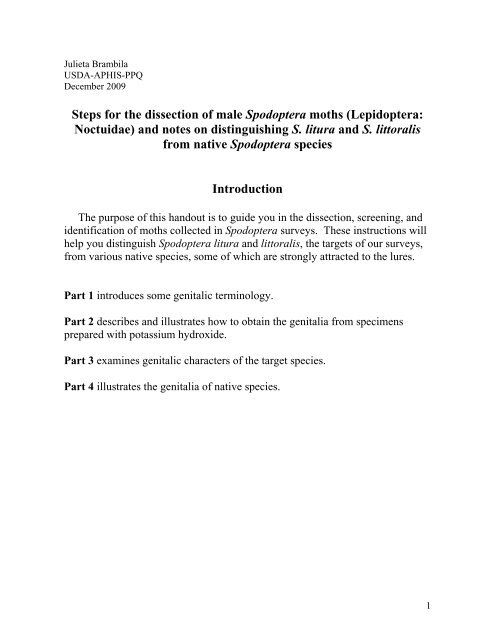

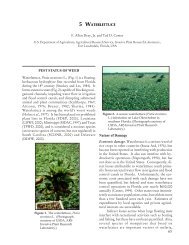

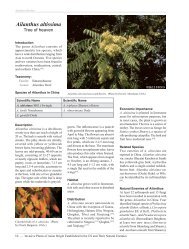
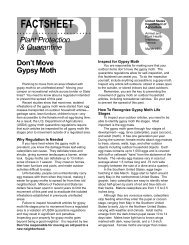
![A Guide to the Control and Management of Invasive Phragmites [PDF]](https://img.yumpu.com/27321025/1/190x190/a-guide-to-the-control-and-management-of-invasive-phragmites-pdf.jpg?quality=85)
